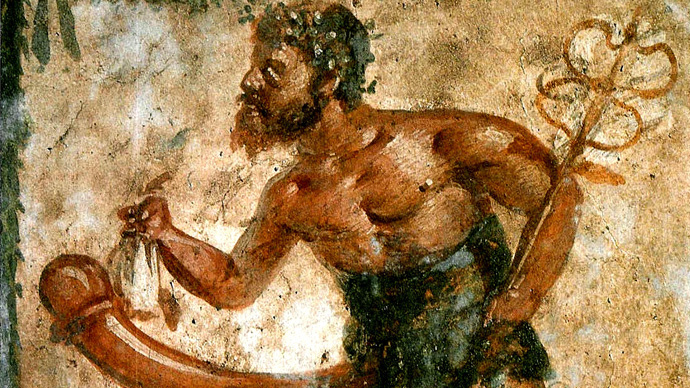Ancient Romans may have had penis problem, Pompeii fresco appears to show

The men of ancient Rome may have suffered from a painful penis problem, an Italian researcher says after studying a rare, surviving 2,000-year-old fresco from Pompeii, the city that was covered with lava in the eruption of Vesuvius.
The fresco, discovered at the entrance to the House of the Vettii in Pompeii, depicts the Roman god Priapus with a large, erect penis, a customary image for the ancient Romans, who wanted to depict their virility. Priapus was a god to be reckoned with, representing all kinds of fertility-related things, from fruit and livestock to male genitalia.
In the fresco, Priapus was suffering from phimosis – a condition of the penis where the foreskin does not fully retract, which can be debilitating in certain forms. And since we usually associate gods with the best in mere mortals, Dr. Francesco Galassi believes the condition afflicted the majority of Pompeii men of the time, according to Discovery News.
"This condition presents different grades of severity, and in this specific case appears to be of the highest grade, in which there is no skin retractability on the glans," he told the website.
READ MORE: ‘Start slow, then go faster’: Norway debuts explicit sex ed show for 8-year-olds (PHOTOS)
Interestingly, Priapus did not appear to have the condition in other frescos, leading Galassi to believe that perhaps a prominent member of the Vettii family suffered from the condition and thought it was a good idea to show that a mighty god can suffer from it too.
But Galassi thought there might be another culprit. “It could be that the condition was so widespread that the artist chose to depict it,” he said.
The sheer amount of penis-shaped objects of wood and stone found in Pompeii convinced Galassi he was on the right track. And he is not the only researcher to have noticed the non-retracting foreskin problem in ancient Roman art.
"Anatomical votive offerings made in Italy between the fourth to second centuries BC do often show the penis with the foreskin closed around the top, as in the later Priapus painting from Pompeii," said Jessica Hughes, lecturer in classical studies at the Open University in the UK.
READ MORE: Young UK Muslims join ISIS to ‘escape sexual frustration’ - documentary
Votives are closely related to healing and fertility, so Hughes – a specialist in the field – believes the artifacts were essentially offerings to the gods by men suffering from phimosis.
This is why she believes the Priapus fresco to be so interesting. The god was supposed to be the opposite of anyone with a foreskin problem, let alone something that could cause sexual dysfunction.
"In this case it’s more challenging for us to understand why the artist would have chosen to represent a biological condition that may have been seen to threaten fertility and health," Hughes told Discovery.
"Perhaps we need to see this painting as a comment on the power of the divine body, which didn't suffer from the same biological limitations as the mortal body."
Priapus also seems to suffer more often than others from penile dysfunction: according to The Local, an academic wrote in 2007 that it was his interpretation that Priapus also suffered from penis gigantism, known as Proteus syndrome.
The problem of phimosis was treatable in ancient Roman times, but involved more painful methods than current treatments, such as circumcision.
Nowadays, it’s easily treatable with a range of techniques and medication.











